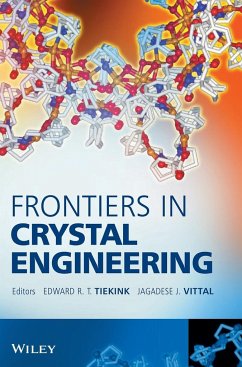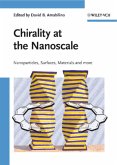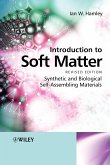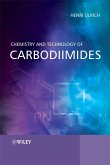Edward Tiekink, Jagadese Vittal
Frontiers in Crystal Engineering
Herausgeber: Tiekink, Edward R T; Vittal, Jagadese
Edward Tiekink, Jagadese Vittal
Frontiers in Crystal Engineering
Herausgeber: Tiekink, Edward R T; Vittal, Jagadese
- Gebundenes Buch
- Merkliste
- Auf die Merkliste
- Bewerten Bewerten
- Teilen
- Produkt teilen
- Produkterinnerung
- Produkterinnerung
Crystal engineering - where the myriad of intermolecular forces operating in the solid-state are employed to design new nano- and functional materials - is a key new technology with implications for catalysis, pharmaceuticals, synthesis and materials science.
Frontiers in Crystal Engineering gathers personal perspectives, from international specialists working in molecular aspects of crystal engineering, on the practical and theoretical challenges of the discipline, and future prospects. These demonstrate the approaches that are being used to tackle the problems associated with the…mehr
Andere Kunden interessierten sich auch für
![Chirality at the Nanoscale Chirality at the Nanoscale]() David B. Amabilino (ed.)Chirality at the Nanoscale101,99 €
David B. Amabilino (ed.)Chirality at the Nanoscale101,99 €![Introduction to Soft Matter Introduction to Soft Matter]() Ian W. HamleyIntroduction to Soft Matter73,99 €
Ian W. HamleyIntroduction to Soft Matter73,99 €![Introduction to Soft Matter Introduction to Soft Matter]() Ian W. HamleyIntroduction to Soft Matter214,99 €
Ian W. HamleyIntroduction to Soft Matter214,99 €![Chemistry and Technology of Carbodiimides Chemistry and Technology of Carbodiimides]() Henri UlrichChemistry and Technology of Carbodiimides177,99 €
Henri UlrichChemistry and Technology of Carbodiimides177,99 €![Block Copolymers Block Copolymers]() Nikos HadjichristidisBlock Copolymers253,99 €
Nikos HadjichristidisBlock Copolymers253,99 €![Organic and Physical Chemistry of Polymers Organic and Physical Chemistry of Polymers]() Yves GnanouOrganic and Physical Chemistry of Polymers156,99 €
Yves GnanouOrganic and Physical Chemistry of Polymers156,99 €![Metal Oxide Varistors Metal Oxide Varistors]() Jinliang HeMetal Oxide Varistors110,99 €
Jinliang HeMetal Oxide Varistors110,99 €-
-
-
Crystal engineering - where the myriad of intermolecular forces operating in the solid-state are employed to design new nano- and functional materials - is a key new technology with implications for catalysis, pharmaceuticals, synthesis and materials science.
Frontiers in Crystal Engineering gathers personal perspectives, from international specialists working in molecular aspects of crystal engineering, on the practical and theoretical challenges of the discipline, and future prospects. These demonstrate the approaches that are being used to tackle the problems associated with the complexity, design and functionality of crytalline molecular solids.
Topics include
_ how intermolecular forces direct and sustain crystal structures
_ functional engineering and design elements
_ coordination polymers and network structures
_ applications in green and pharmaceutical chemistry
Frontiers in Crystal Engineering is a useful guide to this exciting new discipline for both entrants to the field as well as established practitioners, and for those working in crystallography, medicinal and pharmaceutical sciences, solid-state chemistry, and materials and nanotechnology.
Hinweis: Dieser Artikel kann nur an eine deutsche Lieferadresse ausgeliefert werden.
Frontiers in Crystal Engineering gathers personal perspectives, from international specialists working in molecular aspects of crystal engineering, on the practical and theoretical challenges of the discipline, and future prospects. These demonstrate the approaches that are being used to tackle the problems associated with the complexity, design and functionality of crytalline molecular solids.
Topics include
_ how intermolecular forces direct and sustain crystal structures
_ functional engineering and design elements
_ coordination polymers and network structures
_ applications in green and pharmaceutical chemistry
Frontiers in Crystal Engineering is a useful guide to this exciting new discipline for both entrants to the field as well as established practitioners, and for those working in crystallography, medicinal and pharmaceutical sciences, solid-state chemistry, and materials and nanotechnology.
Hinweis: Dieser Artikel kann nur an eine deutsche Lieferadresse ausgeliefert werden.
Produktdetails
- Produktdetails
- Verlag: Wiley & Sons
- 1. Auflage
- Seitenzahl: 352
- Erscheinungstermin: 17. Januar 2006
- Englisch
- Abmessung: 250mm x 175mm x 23mm
- Gewicht: 805g
- ISBN-13: 9780470022580
- ISBN-10: 0470022582
- Artikelnr.: 20779872
- Herstellerkennzeichnung
- Libri GmbH
- Europaallee 1
- 36244 Bad Hersfeld
- gpsr@libri.de
- Verlag: Wiley & Sons
- 1. Auflage
- Seitenzahl: 352
- Erscheinungstermin: 17. Januar 2006
- Englisch
- Abmessung: 250mm x 175mm x 23mm
- Gewicht: 805g
- ISBN-13: 9780470022580
- ISBN-10: 0470022582
- Artikelnr.: 20779872
- Herstellerkennzeichnung
- Libri GmbH
- Europaallee 1
- 36244 Bad Hersfeld
- gpsr@libri.de
Edward R. T. Tiekink is the editor of Frontiers in Crystal Engineering, published by Wiley. Jagadese Vittal is the editor of Frontiers in Crystal Engineering, published by Wiley
List of Contributors.
Foreword.
1. Applications of Crystal Engineering Strategies in Solvent-free
Reactions: Toward a Supramolecular Green Chemistry.
1 Introduction.
1 Mechanochemical preparation of Hydrogen-Bonded Adducts.
1 Mechanically induced formation of covalent bonds.
1 The solvent-free chemistry of the zwitterion.
1 Concluding remarks.
1 Acknowledgements.
References.
2. Crystal Engineering of Pharmaceutical Co-crystals.
1 Introduction.
2 What is the origin of polymorphism and is it prevalent in co-crystals?.
3 What is the pharmaceutical co-crystal?.
4 Conclusions.
5 Acknowledgements.
References.
3. Template-controlled Solid-state Synthesis: Toward a General Form of
Covalent Capture in Molecular Solids.
1 Introduction.
2 Controlling reactivity using linear templates.
3 Template-controlled solid-state reactivity.
4 Target-oriented organic synthesis in the organic state.
5 Other linear templates.
6 Summary and outlook.
References.
4. Interplay of Non-covalent Bonds: Effect of Crystal Structure on
Molecular Structure.
1 Introduction.
2 Second-sphere coordination.
3 Soft coordination environments.
4 Speciation.
5 Molecular conformation.
6 Conclusions.
References.
5. Crystal Engineering of Halogenated Heteroaromatic Clathrate Systems.
1 Introduction.
2 Aromatic edge-edge C-H...N dimers.
3 Heteroatom-1,3-peri interactions.
4 Molecular pen structures.
5 Halogenated edge-edge interactions.
6 Pi-halogen dimer (PHD) interactions.
7 Molecular bricks, spheres and grids.
8 Conclusions.
9 Acknowledgements.
References.
6. Steric Control over Supramolecular Aggregation: A Design Element in
Crystal Engineering?
1 Introduction.
2 Diorganotin carboxylates.
3 Triorganotin carboxylates.
4 Binary zinc xanthates.
5 Bipyridine adducts of zinc dithiophosphates.
6 Binary mercury dithiocarbamates.
7 Binary bismuth xanthates.
8 Conclusions and Outlook.
9 Acknowledgements.
References.
7. Incorporating Molecular Hosts into Network Structures.
1 Introduction.
2 Hydrogen-bonded structures with CTV.
3 Coordination polymers.
4 Extended-arm CTV derivatives and their coordination polymers.
5 Conclusions.
6 Acknowledgements.
References.
8. Interpenetrating Networks.
1 Introduction.
2 Notation.
3 1-D nets.
4 2-D nets.
5 3-D nets.
6 Unusual interpenetration.
7 Consequences of interpenetration.
8 Self-penetration.
9 Entangled but not interpenetrating.
10 Conclusions.
References.
9. Architecture and Functional Engineering Based on Paddlewheel Dinuclear
Tetracarboxylate Building Blocks.
1 Introduction.
2 Synthetic strategy.
3 Architecture engineering based on preorganized building blocks.
4 Conductive and magnetic properties based on preorganized building blocks.
5 Porous properties based on preorganized and in situ building blocks.
6 Conclusion and outlook.
References.
10. Supramolecular Interactions in Directing and Sustaining Coordination
Molecular Architectures.
1 Introduction.
2 Molecular architectures assembled by hydrogen-bonding interactions.
3 Molecular architectures assembled VIA ... Interactions.
4 Metallophilic interactions.
5 Concluding remarks and outlooks.
6 Acknowledgements.
References.
11. The Structure-directing Influence of Hydrogen Bonding in Coordination
Polymers.
1 Introduction.
2 A novel cadmium cyanide network.
3 Dihydroxybenzoquinone and Chloranilic acid derivatives of Lanthanides.
4 A stable zinc saccharate network.
5 Anionic metal-carbonate networks.
6 Conclusions.
References.
12. Hydrogen-bonded Coordination Polymeric Structures.
1 Introduction.
2 Solid-state supramolecular transformation of hydrogen-bonded 3-D network
to 3-D coordination polymetric network structures by thermal dehydration.
3 Interconvertible solid-state supramolecular transformation.
4 Solid-state transformation of a helical coordination polymetric structure
to a 3-D coordination network structure by thermal dehydration.
5 Influence of chiral centers on the helicity of the coordination polymers.
6 Consequences of C=O... interactions.
7 Supramolecular isomerism.
8 Starlike channels and hexagonal diamondoid topology.
9 Hydrogen-bonded helical water molecules inside a staircase 1-D
coordination polymer.
10 Hydrogen-bonded polyrotaxane-like structure containing cyclic (H2O)4 in
[Zn(OAc)2(m-bpe)].2H2O.
11 Summary.
12 Acknowledgements.
References.
Index.
Foreword.
1. Applications of Crystal Engineering Strategies in Solvent-free
Reactions: Toward a Supramolecular Green Chemistry.
1 Introduction.
1 Mechanochemical preparation of Hydrogen-Bonded Adducts.
1 Mechanically induced formation of covalent bonds.
1 The solvent-free chemistry of the zwitterion.
1 Concluding remarks.
1 Acknowledgements.
References.
2. Crystal Engineering of Pharmaceutical Co-crystals.
1 Introduction.
2 What is the origin of polymorphism and is it prevalent in co-crystals?.
3 What is the pharmaceutical co-crystal?.
4 Conclusions.
5 Acknowledgements.
References.
3. Template-controlled Solid-state Synthesis: Toward a General Form of
Covalent Capture in Molecular Solids.
1 Introduction.
2 Controlling reactivity using linear templates.
3 Template-controlled solid-state reactivity.
4 Target-oriented organic synthesis in the organic state.
5 Other linear templates.
6 Summary and outlook.
References.
4. Interplay of Non-covalent Bonds: Effect of Crystal Structure on
Molecular Structure.
1 Introduction.
2 Second-sphere coordination.
3 Soft coordination environments.
4 Speciation.
5 Molecular conformation.
6 Conclusions.
References.
5. Crystal Engineering of Halogenated Heteroaromatic Clathrate Systems.
1 Introduction.
2 Aromatic edge-edge C-H...N dimers.
3 Heteroatom-1,3-peri interactions.
4 Molecular pen structures.
5 Halogenated edge-edge interactions.
6 Pi-halogen dimer (PHD) interactions.
7 Molecular bricks, spheres and grids.
8 Conclusions.
9 Acknowledgements.
References.
6. Steric Control over Supramolecular Aggregation: A Design Element in
Crystal Engineering?
1 Introduction.
2 Diorganotin carboxylates.
3 Triorganotin carboxylates.
4 Binary zinc xanthates.
5 Bipyridine adducts of zinc dithiophosphates.
6 Binary mercury dithiocarbamates.
7 Binary bismuth xanthates.
8 Conclusions and Outlook.
9 Acknowledgements.
References.
7. Incorporating Molecular Hosts into Network Structures.
1 Introduction.
2 Hydrogen-bonded structures with CTV.
3 Coordination polymers.
4 Extended-arm CTV derivatives and their coordination polymers.
5 Conclusions.
6 Acknowledgements.
References.
8. Interpenetrating Networks.
1 Introduction.
2 Notation.
3 1-D nets.
4 2-D nets.
5 3-D nets.
6 Unusual interpenetration.
7 Consequences of interpenetration.
8 Self-penetration.
9 Entangled but not interpenetrating.
10 Conclusions.
References.
9. Architecture and Functional Engineering Based on Paddlewheel Dinuclear
Tetracarboxylate Building Blocks.
1 Introduction.
2 Synthetic strategy.
3 Architecture engineering based on preorganized building blocks.
4 Conductive and magnetic properties based on preorganized building blocks.
5 Porous properties based on preorganized and in situ building blocks.
6 Conclusion and outlook.
References.
10. Supramolecular Interactions in Directing and Sustaining Coordination
Molecular Architectures.
1 Introduction.
2 Molecular architectures assembled by hydrogen-bonding interactions.
3 Molecular architectures assembled VIA ... Interactions.
4 Metallophilic interactions.
5 Concluding remarks and outlooks.
6 Acknowledgements.
References.
11. The Structure-directing Influence of Hydrogen Bonding in Coordination
Polymers.
1 Introduction.
2 A novel cadmium cyanide network.
3 Dihydroxybenzoquinone and Chloranilic acid derivatives of Lanthanides.
4 A stable zinc saccharate network.
5 Anionic metal-carbonate networks.
6 Conclusions.
References.
12. Hydrogen-bonded Coordination Polymeric Structures.
1 Introduction.
2 Solid-state supramolecular transformation of hydrogen-bonded 3-D network
to 3-D coordination polymetric network structures by thermal dehydration.
3 Interconvertible solid-state supramolecular transformation.
4 Solid-state transformation of a helical coordination polymetric structure
to a 3-D coordination network structure by thermal dehydration.
5 Influence of chiral centers on the helicity of the coordination polymers.
6 Consequences of C=O... interactions.
7 Supramolecular isomerism.
8 Starlike channels and hexagonal diamondoid topology.
9 Hydrogen-bonded helical water molecules inside a staircase 1-D
coordination polymer.
10 Hydrogen-bonded polyrotaxane-like structure containing cyclic (H2O)4 in
[Zn(OAc)2(m-bpe)].2H2O.
11 Summary.
12 Acknowledgements.
References.
Index.
List of Contributors.
Foreword.
1. Applications of Crystal Engineering Strategies in Solvent-free
Reactions: Toward a Supramolecular Green Chemistry.
1 Introduction.
1 Mechanochemical preparation of Hydrogen-Bonded Adducts.
1 Mechanically induced formation of covalent bonds.
1 The solvent-free chemistry of the zwitterion.
1 Concluding remarks.
1 Acknowledgements.
References.
2. Crystal Engineering of Pharmaceutical Co-crystals.
1 Introduction.
2 What is the origin of polymorphism and is it prevalent in co-crystals?.
3 What is the pharmaceutical co-crystal?.
4 Conclusions.
5 Acknowledgements.
References.
3. Template-controlled Solid-state Synthesis: Toward a General Form of
Covalent Capture in Molecular Solids.
1 Introduction.
2 Controlling reactivity using linear templates.
3 Template-controlled solid-state reactivity.
4 Target-oriented organic synthesis in the organic state.
5 Other linear templates.
6 Summary and outlook.
References.
4. Interplay of Non-covalent Bonds: Effect of Crystal Structure on
Molecular Structure.
1 Introduction.
2 Second-sphere coordination.
3 Soft coordination environments.
4 Speciation.
5 Molecular conformation.
6 Conclusions.
References.
5. Crystal Engineering of Halogenated Heteroaromatic Clathrate Systems.
1 Introduction.
2 Aromatic edge-edge C-H...N dimers.
3 Heteroatom-1,3-peri interactions.
4 Molecular pen structures.
5 Halogenated edge-edge interactions.
6 Pi-halogen dimer (PHD) interactions.
7 Molecular bricks, spheres and grids.
8 Conclusions.
9 Acknowledgements.
References.
6. Steric Control over Supramolecular Aggregation: A Design Element in
Crystal Engineering?
1 Introduction.
2 Diorganotin carboxylates.
3 Triorganotin carboxylates.
4 Binary zinc xanthates.
5 Bipyridine adducts of zinc dithiophosphates.
6 Binary mercury dithiocarbamates.
7 Binary bismuth xanthates.
8 Conclusions and Outlook.
9 Acknowledgements.
References.
7. Incorporating Molecular Hosts into Network Structures.
1 Introduction.
2 Hydrogen-bonded structures with CTV.
3 Coordination polymers.
4 Extended-arm CTV derivatives and their coordination polymers.
5 Conclusions.
6 Acknowledgements.
References.
8. Interpenetrating Networks.
1 Introduction.
2 Notation.
3 1-D nets.
4 2-D nets.
5 3-D nets.
6 Unusual interpenetration.
7 Consequences of interpenetration.
8 Self-penetration.
9 Entangled but not interpenetrating.
10 Conclusions.
References.
9. Architecture and Functional Engineering Based on Paddlewheel Dinuclear
Tetracarboxylate Building Blocks.
1 Introduction.
2 Synthetic strategy.
3 Architecture engineering based on preorganized building blocks.
4 Conductive and magnetic properties based on preorganized building blocks.
5 Porous properties based on preorganized and in situ building blocks.
6 Conclusion and outlook.
References.
10. Supramolecular Interactions in Directing and Sustaining Coordination
Molecular Architectures.
1 Introduction.
2 Molecular architectures assembled by hydrogen-bonding interactions.
3 Molecular architectures assembled VIA ... Interactions.
4 Metallophilic interactions.
5 Concluding remarks and outlooks.
6 Acknowledgements.
References.
11. The Structure-directing Influence of Hydrogen Bonding in Coordination
Polymers.
1 Introduction.
2 A novel cadmium cyanide network.
3 Dihydroxybenzoquinone and Chloranilic acid derivatives of Lanthanides.
4 A stable zinc saccharate network.
5 Anionic metal-carbonate networks.
6 Conclusions.
References.
12. Hydrogen-bonded Coordination Polymeric Structures.
1 Introduction.
2 Solid-state supramolecular transformation of hydrogen-bonded 3-D network
to 3-D coordination polymetric network structures by thermal dehydration.
3 Interconvertible solid-state supramolecular transformation.
4 Solid-state transformation of a helical coordination polymetric structure
to a 3-D coordination network structure by thermal dehydration.
5 Influence of chiral centers on the helicity of the coordination polymers.
6 Consequences of C=O... interactions.
7 Supramolecular isomerism.
8 Starlike channels and hexagonal diamondoid topology.
9 Hydrogen-bonded helical water molecules inside a staircase 1-D
coordination polymer.
10 Hydrogen-bonded polyrotaxane-like structure containing cyclic (H2O)4 in
[Zn(OAc)2(m-bpe)].2H2O.
11 Summary.
12 Acknowledgements.
References.
Index.
Foreword.
1. Applications of Crystal Engineering Strategies in Solvent-free
Reactions: Toward a Supramolecular Green Chemistry.
1 Introduction.
1 Mechanochemical preparation of Hydrogen-Bonded Adducts.
1 Mechanically induced formation of covalent bonds.
1 The solvent-free chemistry of the zwitterion.
1 Concluding remarks.
1 Acknowledgements.
References.
2. Crystal Engineering of Pharmaceutical Co-crystals.
1 Introduction.
2 What is the origin of polymorphism and is it prevalent in co-crystals?.
3 What is the pharmaceutical co-crystal?.
4 Conclusions.
5 Acknowledgements.
References.
3. Template-controlled Solid-state Synthesis: Toward a General Form of
Covalent Capture in Molecular Solids.
1 Introduction.
2 Controlling reactivity using linear templates.
3 Template-controlled solid-state reactivity.
4 Target-oriented organic synthesis in the organic state.
5 Other linear templates.
6 Summary and outlook.
References.
4. Interplay of Non-covalent Bonds: Effect of Crystal Structure on
Molecular Structure.
1 Introduction.
2 Second-sphere coordination.
3 Soft coordination environments.
4 Speciation.
5 Molecular conformation.
6 Conclusions.
References.
5. Crystal Engineering of Halogenated Heteroaromatic Clathrate Systems.
1 Introduction.
2 Aromatic edge-edge C-H...N dimers.
3 Heteroatom-1,3-peri interactions.
4 Molecular pen structures.
5 Halogenated edge-edge interactions.
6 Pi-halogen dimer (PHD) interactions.
7 Molecular bricks, spheres and grids.
8 Conclusions.
9 Acknowledgements.
References.
6. Steric Control over Supramolecular Aggregation: A Design Element in
Crystal Engineering?
1 Introduction.
2 Diorganotin carboxylates.
3 Triorganotin carboxylates.
4 Binary zinc xanthates.
5 Bipyridine adducts of zinc dithiophosphates.
6 Binary mercury dithiocarbamates.
7 Binary bismuth xanthates.
8 Conclusions and Outlook.
9 Acknowledgements.
References.
7. Incorporating Molecular Hosts into Network Structures.
1 Introduction.
2 Hydrogen-bonded structures with CTV.
3 Coordination polymers.
4 Extended-arm CTV derivatives and their coordination polymers.
5 Conclusions.
6 Acknowledgements.
References.
8. Interpenetrating Networks.
1 Introduction.
2 Notation.
3 1-D nets.
4 2-D nets.
5 3-D nets.
6 Unusual interpenetration.
7 Consequences of interpenetration.
8 Self-penetration.
9 Entangled but not interpenetrating.
10 Conclusions.
References.
9. Architecture and Functional Engineering Based on Paddlewheel Dinuclear
Tetracarboxylate Building Blocks.
1 Introduction.
2 Synthetic strategy.
3 Architecture engineering based on preorganized building blocks.
4 Conductive and magnetic properties based on preorganized building blocks.
5 Porous properties based on preorganized and in situ building blocks.
6 Conclusion and outlook.
References.
10. Supramolecular Interactions in Directing and Sustaining Coordination
Molecular Architectures.
1 Introduction.
2 Molecular architectures assembled by hydrogen-bonding interactions.
3 Molecular architectures assembled VIA ... Interactions.
4 Metallophilic interactions.
5 Concluding remarks and outlooks.
6 Acknowledgements.
References.
11. The Structure-directing Influence of Hydrogen Bonding in Coordination
Polymers.
1 Introduction.
2 A novel cadmium cyanide network.
3 Dihydroxybenzoquinone and Chloranilic acid derivatives of Lanthanides.
4 A stable zinc saccharate network.
5 Anionic metal-carbonate networks.
6 Conclusions.
References.
12. Hydrogen-bonded Coordination Polymeric Structures.
1 Introduction.
2 Solid-state supramolecular transformation of hydrogen-bonded 3-D network
to 3-D coordination polymetric network structures by thermal dehydration.
3 Interconvertible solid-state supramolecular transformation.
4 Solid-state transformation of a helical coordination polymetric structure
to a 3-D coordination network structure by thermal dehydration.
5 Influence of chiral centers on the helicity of the coordination polymers.
6 Consequences of C=O... interactions.
7 Supramolecular isomerism.
8 Starlike channels and hexagonal diamondoid topology.
9 Hydrogen-bonded helical water molecules inside a staircase 1-D
coordination polymer.
10 Hydrogen-bonded polyrotaxane-like structure containing cyclic (H2O)4 in
[Zn(OAc)2(m-bpe)].2H2O.
11 Summary.
12 Acknowledgements.
References.
Index.









